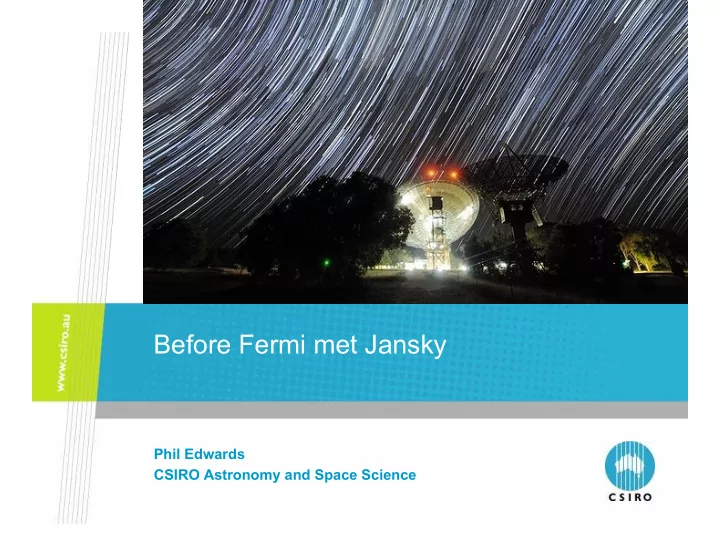

Before Fermi met Jansky Phil Edwards CSIRO Astronomy and Space Science
Overview • Why Roopesh asked me to give this talk • Why I’m not going to give the talk Roopesh asked me to give • 50 th anniversary celebrations • A few observations about EGRET observations • Gamma-ray high states and mm-radio flares • EGRET id’s • The ATCA-PMN sample • VLBI component motions • Intra-Day Variable radio sources • Concluding remarks
31 October 2011
Early results from Parkes • Linear polarisation in extragalactic sources • Synchrotron radiation • Faraday Rotation in Cen A • Faraday Rotation vs ( l,b) • Galactic magnetic field • Location of 3C273 (by lunar occultation) • Discovery of quasars • Southern sky surveys at 408 MHz, 2.7 GHz, 4.8 GHz
Parkes today • About 2/3 of the ~2000 known pulsars were discovered at Parkes • About 2/3 of Parkes observing time is used for pulsar observations: • Timing known pulsars • Following up Fermi detections • Blind survey for new pulsars
1973
Explorer XI • Launched 27 Apr 1961 • First gamma-ray astronomical satellite (E>50 MeV) • Operated for 7 months • Detected 22 gamma- rays and 22,000 cosmic rays
Explorer XI
• SAS-2 • November 1972 – June 1973 • 55% of celestial sphere surveyed • Crab, Vela, Geminga, … • Bignami, Fichtel, Hartman & Thompson (1979) set upper limits for a number of sources, many of which are 2LAC detections • COS-B • August 1979 – April 1982 • Most exposure to galactic plane • Possible detection of 3C273
Conclusions from the EGRET era • AGN are bright, variable gamma-ray sources! • A gamma-ray high state is accompanied by a flare at mm wavelengths and the ejection of a new, often superluminal, component on the parsec scale. • The relative timing of these events is unclear, and so the physical processes were uncertain. • Identifications with Jy-level sources. • There are many unidentified sources. • AGN are more variable than other classes. • Better sky coverage and sensitivity required!
PKS 0420-014 – a 1EG source Valtaoja & Terasranta 1995, A&A
1156+295 – not a 1EG source Valtaoja & Terasranta 1995, A&A
1156+295 – a 2EG source!
So why wasn’t PKS 1921-293 an EGRET source? Courtesy UMRAO
EGRET id’s • Identifications with EGRET sources were made on the basis of: • Proximity • Radio brightness • Spectral index • …. but rarely with contemporaneous data
Courtesy Dave McConnell
Courtesy Dave McConnell
Courtesy Dave McConnell
Courtesy Dave McConnell
EGRET id’s • Iler, Schachter & Birkinshaw (1997) used NVSS fractional radio polarization data to identify EGRET id’s for • 8 unidentified 2EG sources • 4 high confidence 2EG associations • 1 low confidence 2EG association with some success…
3C279 -- UMRAO monitoring
Parsec-scale structure of AGN • High gamma-ray fluxes are correlated with the ejection of new jet components detected with VLBI monitoring (Jorstad et al. 2001) • The limited time coverage of EGRET observations did not enable conclusions to be drawn on whether all new component ejections were accompanied by gamma-ray high states, and vice versa
Mkn 501 TeV variability from 1995 to 1998
Mkn 501 component motions
3C273 -- UMRAO monitoring
Wagner & Witzel 1995, ARA&A
PKS 1622-297 (Wajima et al. 2006, PASJ)
Intra-Day Variability • Extrinsic or instrinsic? • An annual cycle in the IDV of some sources is clear evidence of interstellar scintillation as the cause • Correlated radio and optical IDV in other sources favors an intrinsic origin • In either case, the source must contain a very compact component! • The MASIV survey (Lovell et al. 2003, 2008) studied 443 sources with the VLA • A trade-off is necessary between # sources, # frequencies, and #snapshots in a finite time!
Concluding remarks • Fermi provides great improvements in (among other things) angular resolution, sensitivity, and sky coverage over EGRET • Can we do better than Fermi? • We’re much better placed with complementary radio monitoring campaigns • Single dish, & interferometer multi-epoch, multi- frequency campaigns • All-sky VLBI monitoring of parsec-scale structure • So where does that leave us?
On top of the world! APOD 100803
CSIRO/ATNF Philip Edwards CSIRO ATNF Head of Science Operations Email: Philip.Edwards@csiro.au Web: www.atnf.csiro.au Thank you Contact Us Phone: 1300 363 400 or +61 3 9545 2176 Email: Enquiries@csiro.au Web: www.csiro.au
Recommend
More recommend